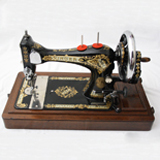Non-Singer Vintage Sewing Machines: A Historical Overview
This section of the singersewinginfo website is devoted to vintage sewing machines that were not made by Singer. While Singer eventually became the most widely recognised name in domestic and industrial sewing, many other manufacturers played important roles in the development and spread of sewing-machine technology during the nineteenth and early twentieth centuries.
The first practical sewing machine that actually worked was patented in 1846 by Elias Howe. His lockstitch design used a needle with the eye at the point, forming a loop on the underside of the fabric. A shuttle carried a second thread through the loop to create the stitch. Although Howe initially struggled to gain interest in his invention, and later faced challenges protecting his patent against competitors such as Isaac Singer and Allen Wilson, his machine formed the basis for early commercial development.
The Growth of Britain’s Early Sewing Machine Industry
By the early 1850s, British makers began building machines inspired by American designs. Sugden and Bradbury were among the earliest, followed by the Pitt Brothers. These companies started production in the early 1850s, and engineers such as James Weir were known to pass off imported machines as their own inventions.
Victorian enthusiasm for new technology encouraged many firms to enter the market. Some, such as the Jones Sewing Machine Company, built long-lasting reputations for solid domestic machines. Others were short-lived. The Moldacot Pocket Sewing Machine Company Limited produced thousands of inexpensive folding pocket machines, but they did not work very well, and the company went bankrupt after only two years.
By the start of the twentieth century, many of the early British companies had disappeared. The Great War further damaged the industry. By the mid-1920s, only Vickers Ltd. and the Jones Sewing Machine Co. Ltd. remained as British-owned manufacturers producing sewing machines in significant numbers, although Singer continued large-scale production at its Scottish factories.
American Manufacturers Beyond Singer
Several American companies contributed to the early industry alongside Singer. Wheeler & Wilson became a major producer before their factory was taken over by Singer. The White Sewing Machine Company began in 1858, when Thomas Howard White invented a small chain-stitch machine sold as the ‘New England’. The company moved to Cleveland in 1866 and was incorporated in 1876. White produced a wide range of machines over many decades.
Willcox & Gibbs became well known for their chain-stitch machines, which remained in production for many years. Other American makers included Williams and the Wanzer Company, whose surviving machines show a variety of mechanisms and designs from the period.
European Manufacturers
Germany became home to several major sewing-machine companies. Frister & Rossmann, founded in Berlin, exported widely and became popular in Britain. Gritzner grew into one of Germany’s largest producers. Haid & Neu developed a range of machines and expanded into large industrial premises. Other Thuringian manufacturers, including Winselmann and Vesta, also produced machines during the late nineteenth and early twentieth centuries.
Veritas represents the later development of East German production, continuing the manufacturing traditions of earlier Thuringian companies. In France, manufacturers such as Bacle produced early machines that reflect the variety of designs appearing across Europe.
Commonwealth and Other International Makers
The sewing-machine industry also extended into the Commonwealth. The Pinnock Manufacturing Company of Australia produced machines for many years, later supplementing production with imported models sold under the Pinnock name. Sunbeam, operating from New Zealand, also marketed machines sourced from outside manufacturers for local sale.
Specialist and Smaller Manufacturers
Some companies followed unusual or highly specialised paths. The Moldacot machine attempted to provide a folding pocket-sized sewing device but proved unreliable in use. The Harris company produced machines sold largely through mail-order catalogues, with different manufacturers supplying models under the Harris name.
Other smaller firms, such as Weir and Gresham in Britain, and companies like Winselmann or Vesta in Germany, contributed to the wide variety of mechanisms, decorative styles, and machine types available during the Victorian and Edwardian periods.
Industry Changes and Later Developments
Many companies faced increasing competition as the industry matured. Some relied on imports or badge-engineered machines to supplement production. German and American manufacturers also supplied machines to markets such as Britain during periods when domestic production declined. The First World War disrupted production, as factories shifted to armaments before returning to sewing-machine manufacture after 1918.
Legacy of Non-Singer Sewing Machines
The many companies represented here—large, small, long-running, or short-lived—produced a wide range of sewing machines that survive today. Their machines illustrate the diversity of early sewing-machine manufacture and the variety of designs, mechanisms, and decorative styles used across different countries and eras.
Machines from Jones, White, Willcox & Gibbs, Frister & Rossmann, Gritzner, Haid & Neu, Winselmann, Pinnock, Sunbeam, Williams, Wanzer, Weir, and Vesta help build a clearer picture of sewing-machine development outside the Singer company.
